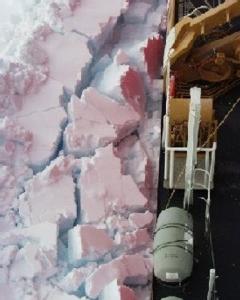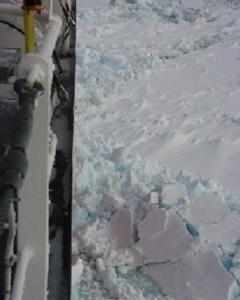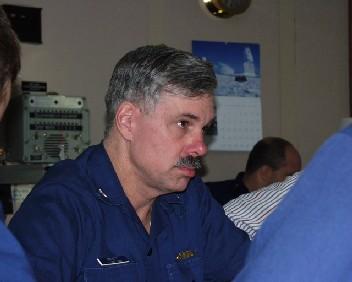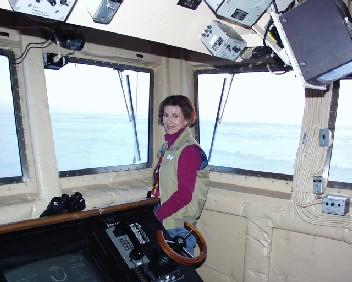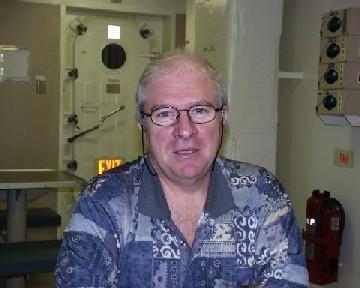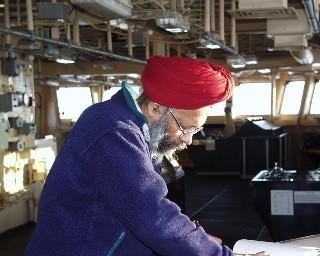
|
2 May, 2000Driving Force DRAFT May 2, 2000 Daily Data (20:30): Lat. 6829.269N Long. 06333.950W Heading 294.401 Air Temp. -11.26C 11.71F True Wind Dir. 297.4 True Wind Speed 11.8 USCGC Healy Facts: Length, Overall: 4200 (128 meters) Beam, Maximum: 820 (25 meters) Draft, Full Load: 293 @ Delivery (8.9 meters) Dear Everyone, Last night I drove the Healy! At the nightly 7:00 PM Captain's meeting, Captain Garrett generously asked me if I'd like to break ice, to drive the Healy. YES! With cameras around my neck and hands free, up from the bridge I climbed the 3 levels of staggered straight-up metal ladders (never looking down!) to the Healy's Aloft Conning Station. What a magnificent view! After a few moments to take in the exquisite panorama, Captain Garrett briefed me on reading the gauges and the mechanics and theory of backing and ramming. Captain Garrett was very close at hand, of course, with his two officers of the deck in assistance. I was given the honor of pulling the levers of the throttle controls upon command for driving the 16,000-ton ship through many backing and ramming phases of ice three to four feet thick with some ridges. The throttle controls regulate the speed of the shaft forewords and backwards. I had the privilege of being in the Aloft Conning Station for one hour and driving the Healy for roughly 40 minutes. It was an unforgettable experience beyond my dreams. What are Narwhals? Late yesterday afternoon when I went up to the bridge to search for some information, I saw James and Stevie glued to the fore windows. They were watching Narwhals! Did I want to have a look? Of course! They handed me the binoculars. There were many Narwhals seen over the course of an hour, but they were at a distance. I watched the colossal black Narwhals at the surface relaxing and spouting and then diving and coming to the surface again. My first Narwhals. Vocabulary of the day: From Roger Provost, Canadian Ice Service, Ottawa, Canada and Robert Wolfe, Research & Development Officer, Ottawa, Marine Transport Canada: Pinched or beset: Surrounded by ice and unable to move, stuck. Vast floe: An ice floe of 2 to 10 km. across. Giant floe: An ice floe of over 10 km. across. Since 8:40 this morning the Healy is pinched. It is now 2:00 PM. We are 55-60 miles from Home Bay. A helicopter reconnaissance flight will go out to look for leads and assess the ice conditions. Why is the Healy pinched? Earlier this morning we were traveling between giant and vast ice floes of thick first year ice. Thick first year ice is over 120 cm. in thickness. There is a giant floe on the port (left) side of the Healy and vast floe on the starboard (right) side. The floes moved more quickly than the Healy, pushed against the sides of the ship and locked it in place. Until the ice floes loosen their grip on the Healy, we will not be able to move. We are listing (tilting) to the starboard (right) side about 1 ° to 2 degrees. Because of the pressure on the sides and the front of the ship, the Healy cannot move. The propellers in the stern of the ship are kept in operation to prevent the ice from damaging the blades. How long will we be here? This is unknown. It could be a few more hours. We are drifting with the floe. As Robert Wolfe said to me, "We are going with the floe." The tide changed at 11:26 AM today, so this could be considered a positive. What we are witnessing and experiencing is the tremendous force of the impact of the floes on the ship. Imagine the weight and momentum of an enormous piece of ice impacting one side of the ship and another floe of similar size and momentum on the other side. Although he assures me that it will not be the case of the Healy, Roger Provost tells me that in some cases the force could be powerful enough to lift a ship. Were moving! Unstuck! It's 2:40 PM. We've returned to backing and ramming, breaking ice. What caused the pinching? We are approaching Home Bay, which means there is land with fast (unmovable) ice attached to it. Next to the fast ice are the moving ice floes. By being in the bay area, there is also the factor of tidal movement. After the tide changed, ice pressure may have relaxed. The wind is moving in the opposite direction of the tides, but it is only approximately three to four knots. Because it is not strong, this factor is not significant. There are forces acting on the top of the ice known as wind drag force and forces under the ice known as water drag force. There are also the forces acting on the sides of the floes from the neighboring ice floes. The net result of all these forces causes the ice floes impacting the Healy to move in a certain direction. Definitions and formula from Devinder Sodhi, Ph.D., US Army Cold Regions Research and Engineering laboratory (CRREL), Hanover, NH: Fluid: Anything that moves that does not have solid shape (i.e. air, water). Fluid velocity: Relative fluid speed. Floe area: Area over which the fluid flows. Fluid density for fresh water: 1000 kilogram/meters^3 Fluid density for air: 1.3 kg/m^3 Drag force: Fluid drag force Coefficient: 0.001 for level ice; 0.005 for ridged ice Fluid drag force = ° (coefficient) (fluid density) (floe area) (fluid velocity)^2 From this formula, you can see that the fluid drag force is proportional to fluid density, floe area and square of relative velocity. The pressure in an ice field results from forces between ice floes and is mainly caused by wind and water drag forces. Water, due to its high density doesn't have to move very fast in order to create a great deal of force. Movement of ice floes is like a person being in a crowd. The movement of one person in a crowd is not totally independent. Which direction the person goes depends upon the other people around them and the other forces around them. I'm hearing cheers and excited voices from the hallway outside my open stateroom door. People are stopping in to briefly chat. Everyone is happy that we are once again breaking ice. I just might be the only person on board who is happy we became beset. Otherwise, I may have never learned about being pinched. Best regards, Sandra For photos and more: ../tea_kolbfrontpage.html For further information: ../ http://www.uscg.mil./pacarea/healy
Contact the TEA in the field at . If you cannot connect through your browser, copy the TEA's e-mail address in the "To:" line of your favorite e-mail package. |




